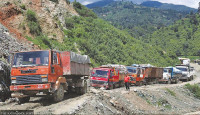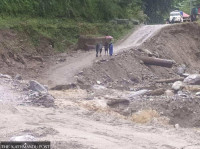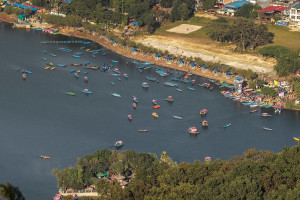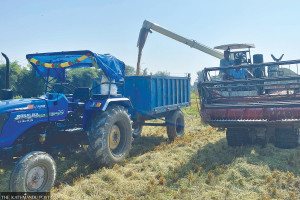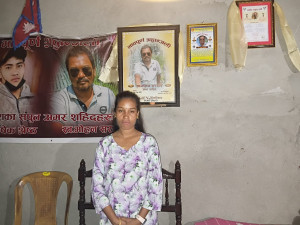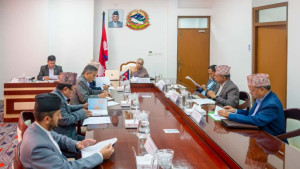Money
Unseasonal rains devastate paddy harvest across Nepal
Farmers in Jumla, Mahottari, Ramechhap, Salyan, and Kapilvastu report massive crop losses as pre-winter downpour inundates ready-to-harvest fields.
Post Report
Farmer Jaya Krishna Dharal of Dharalbada in Jumla is anxious. The rain last Monday disrupted paddy harvesting and inundated his fields just as the crop had ripened.
Farmers reported that the downpour soaked harvested paddy and flattened standing crops, causing significant financial losses.
“We toil hard for six months to produce. Our efforts were wiped out in three days,” said Dharal.
Farmers across multiple districts face heavy losses after pre-winter rains damaged ready-to-harvest paddy crops. In several areas, harvested paddy left in the fields to sun-dry has been submerged.
They say it is rare for pre-winter rains to bring such destruction. Paddy is transplanted across most of Nepal in June and harvested in October-November.
Paddy is Nepal's biggest earning farm commodity, with tens of thousands of farmers depending on its income. High output, according to economists, can help cool inflation and boost the economy. The country has 1.43 million hectares of land suitable for growing paddy.
Experts warn that a drop in output—first from drought during the monsoon and now from pre-winter rainfall—could further strain an economy already weighed down by weak productivity.
According to the agriculture ministry, 95 percent of the 1.37 million hectares of farmland across the country were planted with paddy this year. Transplantation was carried out on 1.3 million hectares, leaving 70,173 hectares fallow—most of it in Madhesh Province, which alone accounted for 50,518 hectares.
For Mannu Pariyar of Jumla, in the mid-western hills, paddy was his financial security for the entire year.
“The harvested paddy is soaked in water in the field. Now, neither the grains nor the straw seems usable,” he said.
Farmers say even if the inundated paddy is dried, it loses quality and traders refuse to buy it.
Many have tried to cover their crops with plastic sheets, while others have carried unthreshed bundles home or tied them up in the fields. But with most fields still waterlogged, finding dry ground to store the crops has become difficult.
According to the District Agriculture Development Office, Jumla, farmers in five of the eight local units had already completed harvesting, while some areas of Tatopani, Hima, and Chandannath rural municipalities were still in the process.
Around 20 percent of the district’s 2,890 paddy fields are submerged. Farmers fear the grains will sprout and the straw will rot due to continuous rainfall.
In Mahottari, farmers who had planted late due to drought also face similar problems.
Awadh Kishor Mahato of Ward 12 in Bardibas Municipality, who leased two bighas (13,545 square metres) of land, said the rain destroyed his family’s year-round food supply and the income he relied on for household expenses.
“We were already a month late planting because of the dry spell in the monsoon, from mid-June to mid-September. Now, just when the crop was ready, the rain ruined it,” he said.
Mahato, who usually produces 200 quintals of paddy annually, said this year’s yield was already low due to delayed planting. “Whatever remained has been washed away,” he added.
Naini Kumari of Aurahi Municipality harvested paddy on 10 katthas (3,386 square metres) of leased land but could not save her crop. She is now worried about managing her finances.
“Half the crop goes to the landowner. I depend on the rest to feed my family for a year,” she said.
Earlier this monsoon, drought in Madhesh Province had forced authorities to distribute drinking water by firetrucks, prompting the government to declare the region drought-hit. The rains came later, reducing the potential losses. But this pre-winter downpour became another spoiler.
According to the Agriculture Knowledge Centre, Mahottari saw paddy transplantation on only 30,137 hectares—roughly three-fourths of the usual area. Only 34,000 hectares of the district’s 70,000 hectares of cultivable land have irrigation facilities.
Farmers said the pattern of drought during transplantation and rain during harvest has repeated in recent years, making paddy farming increasingly uncertain. “At this rate, we may not even have enough to feed our family,” said Mahato.
In Ramechhap, the effect of continuous rain since Wednesday has been significant.
“We never imagined it would rain at this time,” said Suraj Shrestha of Ward 7 in Manthali Municipality. “The fields are flooded, and the harvested paddy is already sprouting.” Farmers in Manthali and nearby areas said rain flattened the standing crops.
Yowan Kumar Sunuwar, agricultural economist at the Agriculture Development Office in Manthali Municipality, said pre-winter rains have become a major problem for farmers rushing to harvest their main crop.
“Farmers who regularly follow weather updates were able to protect their paddy,” he said. “But those without such information suffered losses due to the rain.”
According to the Ramechhap Agriculture Development Office, the district has around 7,859 hectares of paddy fields, with over 7,200 hectares planted this year. Last year, production stood at about 20,015 tonnes.
In Salyan, farmers who had just begun harvesting after Tihar said the rain has made drying nearly impossible. “We were waiting for threshing machines, but before they arrived, the rain began,” said Bhim Bahadur Nepali of Ward 9 in Sharada Municipality.
Local officials said Salyan’s 7,000 hectares of paddy fields could produce 28,000 tonnes in normal years.
The southern plains of Kapilvastu have been hit the hardest. Out of 62,907 hectares of paddy fields, only about 25 percent had been harvested, said Ghanshyam Chaudhary, chief of the Agriculture Knowledge Centre.
He said the rain has damaged both standing and cut crops, especially early-maturing varieties such as Gorakhnath and Radha 4 and 6.
Local offices are assessing losses in coordination with municipalities.
Farmers across the affected districts said the unseasonal downpour has left them uncertain about how much of their year’s main crop can still be saved.
(DB Budha in Jumla, Sunita Baral in Mahottari, Nawaraj Shrestha in Ramechhap, Biplab Maharjan in Salyan, and Manoj Paudel in Kapilvastu contributed reporting.)




 17.12°C Kathmandu
17.12°C Kathmandu
